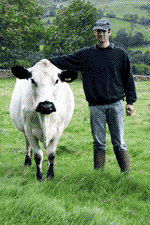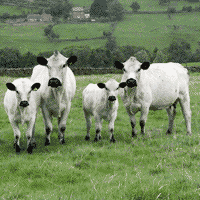British White beef a hit with top restaurateurs

Beef produced from British White cattle – one of the UK’s rarest breeds – is creating a frenetic demand among leading butchers and top chefs.
Yorkshire Dales breeder Andrew Fisher is starting to expand his British White herd at Pateley Bridge, Harrogate. But in the meantime he’s scouring the country in search of cattle to meet an order to supply beef to one of the north of England’s most famous specialist food retailers.
 |
|---|
| Demand for British White beef is proving difficult to meet, says Andrew Fisher. |
In Lancashire, where the breed was created over 500 years ago by the monks of Whalley Abbey, celebrity Michelin-starred chef Nigel Haworth has been the driving force behind the setting up of a herd of 90 cows to supply his expanding string of restaurants – recognition of the distinct eating qualities of British White beef that breed society secretary Angela Hamilton says is firing demand across the country.
Mr Fisher’s Nidderdale herd – run alongside Swaledale ewes and his well-known flocks of Bluefaced Leicesters and Teeswaters – was established four years ago. The herd’s 24 cows will soon be joined by eight heifers but an order for one British White beast a week from the award-winning specialist food retailers Weetons, run by Andrew Loftus, means he now needs a year-round supply of cattle from other breeders.
“Suddenly everyone is waking up to British White beef,” says Mr Fisher. “Weetons has a big reputation and a famous butchery counter. After taking just one British White the shop had so many customers wanting more that we got the order. But it’s still not easy finding the cattle.”
Mr Fisher produces grass-finished steers at about 22 months. Surplus spring-born bull calves are yarded in October to finish on a barley-based ration at 12-14-months weighing 500kg-plus. The breed is well known for its high killing-out percentage.
Correctly marked British Whites need distinctive black ears, while black hooves are responsible for the breed’s reputation for good feet. Cows must have black teats.
“The cows are docile and naturally polled. The breed was originally dual-purpose, so they are naturally good milkers. The British White is hardy and can be out-wintered,” he adds.
Lancashire dairy farmer Robert Townson milks 250-cows at Westby Farm near Gisburn, but he’s also managing a herd of 90 British Whites to supply beef to the chain of restaurants run by celebrity chef Nigel Haworth, whose famous Three Fishes restaurant – only a stone’s throw from the birthplace of the breed at Whalley Abbey – has been the flagship for promoting British White beef.
 |
|---|
| Hardy British White cattle finish well off grass at 500-600kg liveweight. |
“We’ve been involved with the breed for about two years and run about 180 head, with most going to Nigel Haworth’s restaurants. The quality of the beef is outstanding and is pushing up demand for British Whites. We’re producing finished steers at 18-24-months old reaching 500-600kg,” says Mr Townson.
Although the British White originated in Lancashire and is now regaining popularity in the north, its stronghold for many years has been in Norfolk. Mrs Hamilton also manages the Woodbastwick herd – established in 1840 – owned by the Cator family at Norwich.
There are about 1500 British White females in the UK. Many are kept in small numbers, but there are about 20 commercial herds and a growing interest from farmers considering moving into a native breed to supply top quality beef to specialist outlets.
“This is a great time for the British White. The breed has always had it’s stalwart supporters, but now things are really taking off, not only because of the demand for the beef, but because these cattle are so easily managed and can produce a high quality and high value carcass from grass.
“Anyone who tries British White beef only have to taste the depth of flavour once to know why the demand is growing so rapidly. I’ve just had one butcher phone me who wanted six beasts a week,” adds Mrs Hamilton.
Finished bulls produced from the Woodbastwick herd at 14-15 months old are reaching 320-340kg deadweight, with most classifying R4L, but some do achieve U-.
“Although the British White is still classified as a rare breed numbers are increasing. Anyone thinking about going into the breed should be able to find enough females to set up a viable herd,” she says
Native breeds at the Dairy Event and Livestock Show

Native breeds will make their debut in an exhibition at the Dairy Event and Livestock Show at Stoneleigh Park, Warwickshire on 17 and 18 September.
The Native Breeds for Modern Needs Exhibition, developed in association with Rare Breeds Survival Trust will demonstrate how these cattle, sheep, goats and pigs can be used to produce high quality added value products. The exhibition will also highlight the advantages of using native breeds to manage land on extensive, low-cost production systems.
Along with the Native Breeds exhibition, there will be three other new exhibitions featuring at this year’s event.
The Sheep Exhibition will feature the leading UK breeds and focus on grassland management, nutrition and solutions to animal health issues, and will also offer a live demonstration using the latest ID and handling systems throughout the two-day event.
Beef will come under the microscope in a new exhibition for suckler producers, finishers and pedigree breeders. Developed in association with NBA, sponsored by EBLEX, the Beef Exhibition will focus on areas for cost saving and improved efficiency and feature a variety of exhibits of relevance to all members of the sector from handling to housing, and genetics to generating added value.
The Commercial Goat Exhibition, developed in association with the British Goat Society, will focus on milking techniques, nutritional advice and solutions to animal health issues, together with a series of practical demonstrations, including AI. A display of commercial breeds will indicate which is best suited to either dairy, meat or fibre production.
